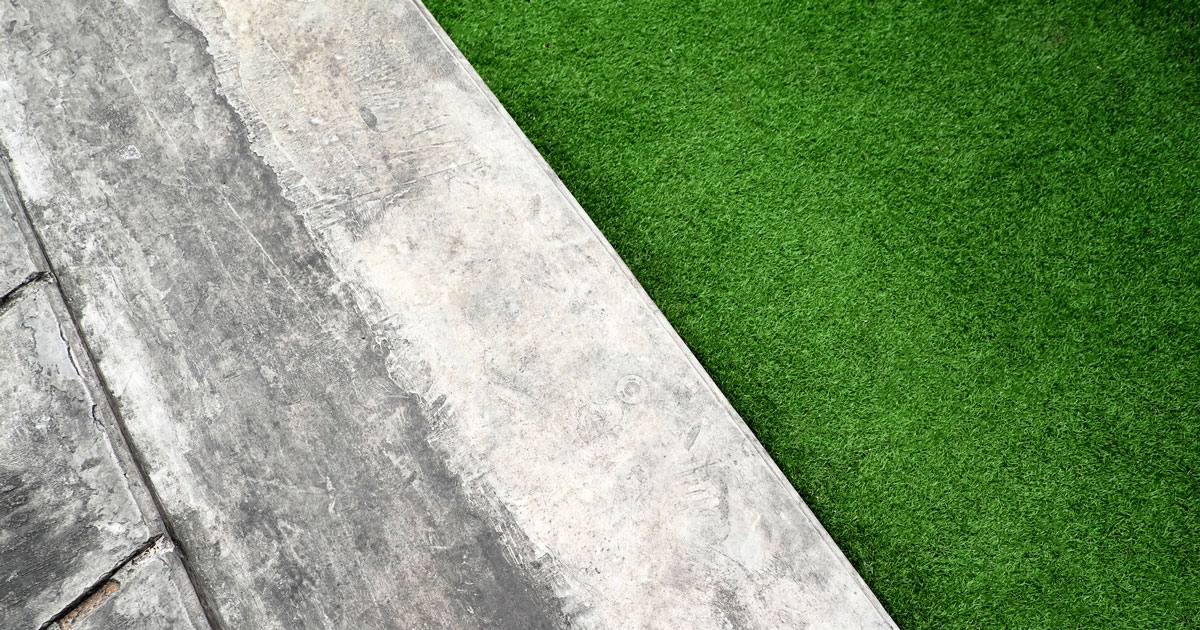We Supply. We Install. We Do it All.
Essex Artificial Grass Experts
If you’re looking to remodel your place, turning a dull concrete patio into a faux garden can transform your home through much-needed greenery minus the mud and dirt.
However, if you can’t afford to set aside a budget to hire professionals, we have your back. You can undoubtedly lay artificial grass on concrete with this simple guide.

First of all, don’t install artificial grass over concrete directly if:
It’s crucial to note that the concrete must be flat and stable. Some concrete floors aren’t cut out for artificial grass installation. That’s due to the wobbly stones, slabs, and large cracks (wider than 20mm) they contain, which cause parts of the concrete to come loose.
If the concrete cracks are minor and contained, you may rectify them with a self-levelling mixture. The latter can be found in DIY shops and can be installed with only water.
However, if they aren’t, you may not be able to lay artificial grass directly on top, so a better course of action would be breaking out existing concrete or building a new solid base.
With inadequate drainage, you might find your artificial lawn soaked in water, which may damage it. If some parts of your concrete are higher than others, this will create puddles. Therefore, a slightly inclined surface is perfect for drainage, making it easy for water to slide off.
Still, there’s the question of how you can tell if the drainage is good enough. A smart way to test this is by letting the UK rain do its trick or hosing the concrete down before checking for puddles.
If you do find the lawn soaked in water, that can be resolved with some holes for water to drain. You can use a 16mm drill bit, drill these holes wherever puddles form and stuff them using pea gravel so that water can escape and be absorbed.
This is quite the project to take on, but we’ll assist you however we can. If you’d like our help, you can contact us at Essex Artificial Grass. We offer a diverse selection of the most naturally-produced artificial grass.
Moreover, our team carries out the installation process professionally, employing efficient, high-quality techniques.
Still, if you’d rather DIY it, this is a 6-step guide to laying artificial grass over concrete.
We urge you to clean the concrete because it helps the artificial grass adhesives bond properly with it. You can do that by hosing or brushing it with a stiff broom. Of course, a power washer would be even better.
This also entails removing weeds, debris, and moss. You could even consider applying a weed killer if the situation is entirely out of hand.
After cleaning, leave your concrete until it dries – that’ll also provide you with an excellent chance to notice whether the drainage is good or there are too many puddles. If so, you can drill the drainage holes as previously elaborated.
The foam underlay is typically wrapped in a roll, so place it on one concrete edge. Then, roll out a foam piece and temporarily hold it down with a heavy object on each side (so it won’t automatically roll itself back up). This foam layer evens out any slight concrete irregularities (bumps and cracks) and provides some cushioning.
Tip: If you want extra cushioning for kids to play around comfortably, you can opt for a thicker grass product of 10mm thickness (instead of the regular 5mm).
Afterwards, you can cut the foam into the needed shape and repeat this with all the foam pieces before glueing. Another pre-glue step is to tape the pieces together using masking tape.
To glue it, use multi-purpose adhesives rather than artificial grass adhesives, specifically 5 or 10 kg two-part adhesives for various functions.
To estimate how much glue is required, you need to find out how many metres the lawn perimeter is and multiply that by two because you’ll need enough adhesive to cover the lawn twice – once to secure the foam underlay and another to secure the artificial grass.
Moreover, you need to measure the joints’ lengths, as you’ll need the grass joints glued to each other the way the foam pieces are taped.
Now that you have your measurements down, note that a 5kg container covers about 12m, and a 10kg container covers about 24m if spread at a 300mm width. Factor that in when you’re calculating the number of tubs needed.
Add the hardener to the glue tubs and blend them well using a drill and a paddle mixer. After that, you can apply the adhesive to the concrete with a filing or stripping knife at a 200-300mm width and add a 2-3mm glue coat for adequate bondage. The glue takes about 30 mins to dry, so you have to be quick.
Tip: If your concrete can drain the water with no drainage holes, leaving gaps when glueing allows water to slide.
Roll out an artificial grass piece so that it covers the foam, turn it over, and use a Stanley knife to cut it carefully, leaving an overhang of at least 50mm.
Try to get as close as you can to the stitching without touching it. If you have joints, trim three stitches off every grass piece’s edge, creating an invisible join. Then, repeat for every piece.
Leave the grass for 2 to 3 hours or a full night. This gives it time to smooth out any creasing caused by packaging or storage. When enough time has passed, artificial grass tape can glue the joints together and wait until they dry off.
Firstly, you fold the grass back at its ends. Secondly, you apply a glue coat to the full lawn perimeter, leaving 20mm gaps for water drainage. And thirdly, you don’t step on the grass for a couple of hours.
About 4-5kg of kiln-dried sand is applied per square metre to keep the structure of the artificial lawn firm and rigid with no wrinkling or creasing.
Finally, we advise you to brush the grass against the grain using a stiff broom to help lift its fibres since they may be slightly tilted.
Laying artificial grass on concrete could become a DIY project for you and your family if you follow the steps we just covered. What matters the most is understanding your concrete’s condition and accommodating it.
It would help if you were informed of your concrete’s inclination, stability, cracks, and measurements. Then, installing the foam underlay and artificial grass becomes easier.
Just imagine how satisfying that finished look could be! And if not, you could always reach out to us at Essex Artificial Grass and request a quote for a hassle-free service.
Like this article?
